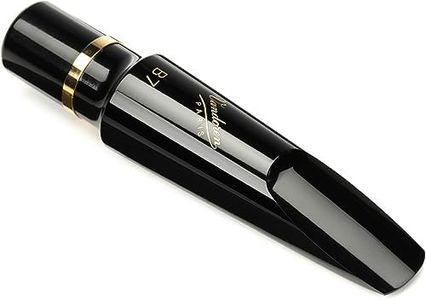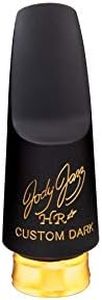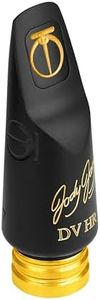10 Best Sax Mouthpieces 2025 in the United States
Our technology thoroughly searches through the online shopping world, reviewing hundreds of sites. We then process and analyze this information, updating in real-time to bring you the latest top-rated products. This way, you always get the best and most current options available.

Our Top Picks
Winner
JodyJazz HR* Alto Saxophone Mouthpiece Model 7M (.083")
The JodyJazz HR* Model 7M (.083) alto saxophone mouthpiece is a hand-crafted rubber mouthpiece known for producing a warm and versatile tone that suits both traditional and modern styles. Its .083" tip opening strikes a balance that allows for good control while still offering free-blowing power and strong projection—great if you want an expressive sound that can cut through a band or ensemble. The mouthpiece’s chamber and facing are designed to blend warmth with brightness, making it a good fit for players seeking a rich tone that isn’t too edgy or too dark.
Being individually play-tested ensures consistent quality and reliability. On the downside, rubber mouthpieces like this one might require a bit more maintenance to keep clean compared to metal or synthetic options. Also, while it’s versatile, very aggressive or extremely bright playing styles might benefit from mouthpieces with different tip openings or baffles.
This mouthpiece appeals most to intermediate to advanced alto sax players who want a dependable, warm sound with good projection for jazz, contemporary, or even some classical settings.
Theo Wanne Durga 5 Tenor Saxophone Mouthpiece - 24 Carat Gold Plated - Long Step Baffle - Bright and Contemporary - Powerful & Warm Core Sound - Large Chamber Includes Ligature and Reed Replacer Cap
The Theo Wanne Durga 5 Tenor Saxophone Mouthpiece is a high-end option for saxophonists seeking a blend of power and warmth in their sound. Crafted with 24-carat gold plating, this mouthpiece not only looks premium but is designed to produce a bright, contemporary tone. One of its standout features is the innovative Medium-Stadium-Chamber, which, coupled with a long-step baffle, is engineered to optimize sound balance and efficiency—a concept inspired by the 'boundary layer effect' seen in golf ball dimples.
Musicians who play Jazz, R&B, or Rock & Roll might find the powerful and sensual tones that the Durga 5 delivers particularly appealing. Its design by notable expert Theo Wanne ensures consistency and quality, making it suitable for both novice and professional players. The mouthpiece is built in the USA with top-notch materials and advanced machining, reflecting its high status among saxophone accessories.
The Durga 5 would be a valuable addition for serious saxophonists looking for a mouthpiece that offers a robust yet warm sound, and who are willing to invest in a piece that stands out both in craftsmanship and performance. The included ligature and reed replacer cap are practical extras, enhancing its appeal for those who want a comprehensive package. Potential buyers should note that the gold-plated finish might suggest a higher price point, which may not be justifiable for casual players or beginners on a tight budget. The unique chamber and baffle design may require some adjustment time for those used to traditional mouthpiece designs.
Vandoren SM711 AL3 Optimum Series Alto Saxophone Mouthpiece
The Vandoren SM711 AL3 Optimum Series Alto Saxophone Mouthpiece is designed with classical saxophonists in mind. Made of brass, it offers durability and a solid feel, which is a key factor for any musician looking for a reliable mouthpiece. The tip opening of 152 (1/100mm) and the medium long facing length make it versatile and suitable for a range of playing styles, though it particularly shines in classical music due to its exceptional roundness of tone.
The chamber size is not explicitly mentioned, but the mouthpiece's design aims to produce a warm and rich sound, which aligns well with its classical focus. The mouthpiece works best with Vandoren #2.5-#4 reeds, providing flexibility for players to find their preferred reed strength. However, those who prefer softer or harder reeds may find this limiting. The baffle design is not specified but contributes to the balanced and refined sound quality.
With a weight of just 0.8 ounces and compact dimensions, it is easy to handle and transport. While it may not be the best fit for jazz or contemporary music styles, it excels in providing a classic, warm tone ideal for classical performances. The Vandoren SM711 AL3 is a strong choice for alto saxophonists aiming for a high-quality, reliable mouthpiece dedicated to classical music.
















